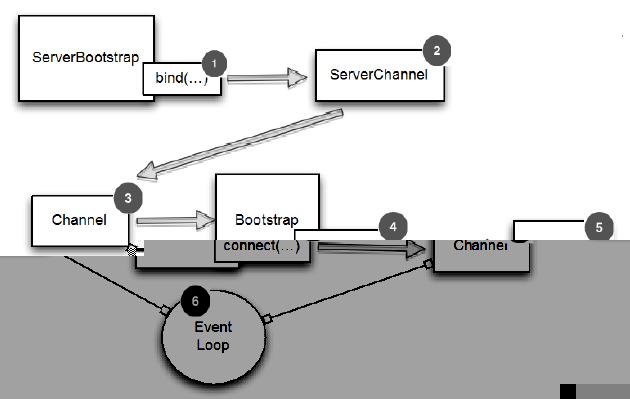- 从 Channel 引导客户端
从 Channel 引导客户端
有时你可能需要引导客户端 Channel 从另一个 Channel。这可能发生,如果您正在编写一个代理或从其他系统需要检索数据。后一种情况是常见的,因为许多 Netty 的应用程序集成现有系统,例如 web 服务或数据库。
你当然可以创建一个新的 Bootstrap 并使用它如9.2.1节所述,这个解决方案不一定有效。至少,你需要创建另一个 EventLoop 给新客户端 Channel 的,并且 Channel 将会需要在不同的 Thread 间进行上下文切换。
幸运的是,由于 EventLoop 继承自 EventLoopGroup ,您可以通过传递 接收到的 Channel 的 EventLoop 到 Bootstrap 的 group() 方法。这允许客户端 Channel 来操作 相同的 EventLoop,这样就能消除了额外的线程创建和所有相关的上下文切换的开销。
为什么共享 EventLoop 呢?
当你分享一个 EventLoop ,你保证所有 Channel 分配给 EventLoop 将使用相同的线程,消除上下文切换和相关的开销。(请记住,一个EventLoop分配给一个线程执行操作。)
共享一个 EventLoop 描述如下:

- 当 bind() 调用时,ServerBootstrap 创建一个新的ServerChannel 。 当绑定成功后,这个管道就能接收子管道了
- ServerChannel 接收新连接并且创建子管道来服务它们
- Channel 用于接收到的连接
- 管道自己创建了 Bootstrap,用于当 connect() 调用时创建一个新的管道
- 新管道连接到远端
- 在 EventLoop 接收通过 connect() 创建后就在管道间共享
Figure 9.4 EventLoop shared between channels with ServerBootstrap and Bootstrap
实现 EventLoop 共享,包括设置 EventLoop 引导通过Bootstrap.eventLoop() 方法。这是清单9.5所示。
ServerBootstrap bootstrap = new ServerBootstrap(); //1bootstrap.group(new NioEventLoopGroup(), //2new NioEventLoopGroup()).channel(NioServerSocketChannel.class) //3.childHandler( //4new SimpleChannelInboundHandler<ByteBuf>() {ChannelFuture connectFuture;@Overridepublic void channelActive(ChannelHandlerContext ctx) throws Exception {Bootstrap bootstrap = new Bootstrap();//5bootstrap.channel(NioSocketChannel.class) //6.handler(new SimpleChannelInboundHandler<ByteBuf>() { //7@Overrideprotected void channelRead0(ChannelHandlerContext ctx, ByteBuf in) throws Exception {System.out.println("Reveived data");}});bootstrap.group(ctx.channel().eventLoop()); //8connectFuture = bootstrap.connect(new InetSocketAddress("www.manning.com", 80)); //9}@Overrideprotected void channelRead0(ChannelHandlerContext channelHandlerContext, ByteBuf byteBuf) throws Exception {if (connectFuture.isDone()) {// do something with the data //10}}});ChannelFuture future = bootstrap.bind(new InetSocketAddress(8080)); //11future.addListener(new ChannelFutureListener() {@Overridepublic void operationComplete(ChannelFuture channelFuture) throws Exception {if (channelFuture.isSuccess()) {System.out.println("Server bound");} else {System.err.println("Bound attempt failed");channelFuture.cause().printStackTrace();}}});
- 创建一个新的 ServerBootstrap 来创建新的 SocketChannel 管道并且绑定他们
- 指定 EventLoopGroups 从 ServerChannel 和接收到的管道来注册并获取 EventLoops
- 指定 Channel 类来使用
- 设置处理器用于处理接收到的管道的 I/O 和数据
- 创建一个新的 Bootstrap 来连接到远程主机
- 设置管道类
- 设置处理器来处理 I/O
- 使用相同的 EventLoop 作为分配到接收的管道
- 连接到远端
- 连接完成处理业务逻辑 (比如, proxy)
- 通过配置了的 Bootstrap 来绑定到管道
注意,新的 EventLoop 会创建一个新的 Thread。出于该原因,EventLoop 实例应该尽量重用。或者限制实例的数量来避免耗尽系统资源。
